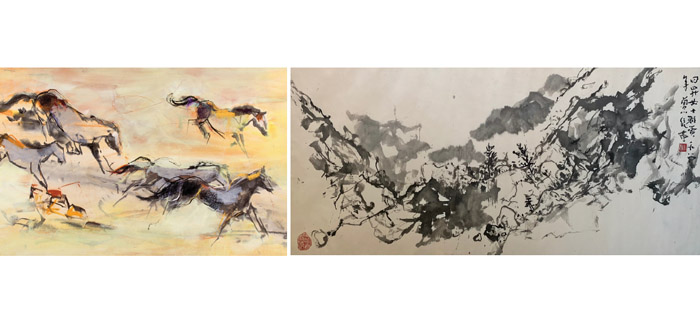((Left) Dawn Emerson’s Just Passing Through, 30”x48”, mixed media on Evolon. (Right) Zeng Xiaojun’s Landscape, Chinese ink on paper, 24”x48”)
As one embarks upon and pursues the artist’s path, a multitude of influences crosses it, from fellow creatives and teachers to travels both exotic and mundane as well as the many great masterworks that comprise the art historical canon. Encountering these influences, the emerging creator may admit or discard them as he or she sees fit, at least those that register on a conscious level (Conscious rather than subconscious influences drive the current content). The choice is essentially a matter of taste, one that accords with a particular disposition.
A college art education with its requisite art history courses aims to ensure the student is adequately versed in one’s discipline, recognizing and understanding masterworks and what specifically makes them so. These great artworks of both the near and distant past fulfill part of their purpose, namely education / instruction, by exerting their influence over the open-minded learner seeking to find her personal means of expression. Through the general appeal of these chef d’oeuvres and the specific qualities admired in them, the searching artist extracts inspiration and emulates them through the lens of his or her own art spirit.
As the artist pursues the creative journey, past influences may appear irrelevant as new ones step in their stead. Those truly on a quest of discovery embrace the constancy of change as part and parcel of their practice. Each new work represents an opportunity to explore, for example, a novel color harmony, note sequence or technique of application, the idea for which may have derived from the art of another. Despite the romantic notion of the solitary creator, few artists today create in a vacuum, especially as various social media platforms allow for the ubiquitous dissemination of images. A painter myself, I can personally attest to Instagram’s appeal as I discovered and currently “follow” a group of Australian painters whose art has certainly affected my own. This example illustrates how contemporary artists share and discover through each other’s work, just as Matisse and Picasso influenced (to the point of rivalry, some argue) one another through their ever-changing, creative projects. In other instances, an artist may draw inspiration from the past, as van Gogh did from Millet, as de Kooning did from Soutine, or as most everyone who painted after the turn of the 20th century did from Cezanne.
This new series (one article every other month), Artists and Their Influences, explores the ways in which artistic masters and masterpieces shape the work of several Oregon artists, all of whom are quite masterful themselves. I’ve asked these Oregonian creatives to identify and describe one or two central influences on their work and provide images that illustrate this influence. For this article, I spoke with Dawn Emerson, an award-winning, mixed-media artist who creates stunning representational imagery that maintains a focused dialogue with abstraction. Perhaps best known for her dynamic horses and ominous ravens, Emerson moves fluidly with any subject, her gestural marks and pronounced value structures epitomizing her style.
When asked about influences on her work, Dawn quickly noted several, including the pen and ink drawings of van Gogh, the found-object horse sculptures of Deborah Butterfield and the dramatic paintings of Tibor Nagy. But the two individuals she selected as most prominent, at least in terms of her current investigations, are Rick Bartow (1946-2016), “one of Oregon’s most important contemporary artists,” and Zeng Xiaojun, Chinese painter, teacher and scholar (Rick Bartow: Things You Know But Cannot Explain, p.6).
From Bartow, Emerson extracted much value not only from his artworks, especially his drawings rendered in pastel and graphite, but also from his work ethic. “There is so much to admire in Bartow’s work,” Dawn explains, “the coloration, the use of negative space, the marks, the ease with which he executed his monotypes, always the composition, as well as the story he conveys, the connection between his personal life and the way he used art to heal himself.” She continues, “His work is unbelievably sensuous, incredibly dynamic and full of life; viewing it is like watching the process of transformation happen before me.” For those who know Bartow’s work, Emerson’s assessment of its qualities are clearly spot on, and for those who know Emerson’s work, the connection with Bartow is an aptly vivid one. Whereas Bartow chose to explore the power and mystery of the crow, Emerson opted for the equally powerful and mysterious raven. Both artists, however, brilliantly merge representational and abstract qualities in their depiction of these and other subjects, leaving as much unstated as stated, a visually and psychologically compelling component of their artistry.
Bartow’s life was not an easy one. A Vietnam Veteran, multiple stroke survivor, recovering alcoholic and widower, Bartow, a member of the Mad River Band of Wiyot Indians, employed art, both painting and music, as a survival mechanism. His large-scale paintings, drawings, prints and sculptures have been widely collected and featured in more than one-hundred solo exhibitions at galleries and museums (froelickgallery.com/artists/26-rick-bartow). “The man never stopped working,” Emerson exclaims. “He worked through everything by keeping himself busy and, although I thankfully don’t share such dark moments, his work and work ethic illustrate how healing art can be,” Dawn concludes. As a deep admirer of an artist so incredibly prolific and exploratory, it comes as no surprise that Emerson has exhibited at multiple galleries throughout the U.S., leads her own pastel workshops, authored a book printed in four languages and produced six instructional DVDs as well as a recent video featured on Vimeo titled “Breaking New Ground.”
A second major influence that Dawn Emerson cites as pivotal to her art is that of Zeng Xiaojun, an accomplished painter who is now a connoisseur and collector of historic Chinese furniture, artwork and antiquities. Dawn reports, “I met Xiaojun in Massachusetts when he was living with his wife, Nancy Berliner, in Boston. He was teaching an evening class in Chinese Brush Painting at this local community center in Brookline, getting paid next to nothing, and I was working as a book designer for the DC Heath Publishing Company just outside Boston. He is a tiny person, less than five feet tall, slight and soft spoken yet he worked on huge pieces of paper on a table, and his entire body would vibrate as he wielded his brush. I was dumbfounded. I learned about painting rocks and trees from him. He told us (through his wife’s translation) and demonstrated that each mark in a painting had to be unique and a response to the energy of the subject. Every inch of his paintings are alive.”
Such vivacity and intentionality in mark-making is clearly evident in Emerson’s depictions of animals and landscapes, all of which reveal her affinity for the art of Chinese brush painting and its focus on the essential. “I have used sumi ink since I studied with a Japanese woman when I was twelve,” she explains, “and I’d spend hours trying to perfect my strokes. It wasn’t until my late twenties when I took the classes with Xiaojun, a true master, that I began to understand the passion and energy behind Chinese brush work, a mastery that comes from years of intense observation, practice and memory.” With miles of canvas behind her now and several key influences that have shaped her practice, Dawn Emerson stands out as one of Oregon’s finest artists whose work widely and deeply influences the art of others.
To learn more about the art and instruction of Dawn Emerson, visit her website at dawnemerson.com. To view her art in person, visit Mockingbird Gallery in Bend.



